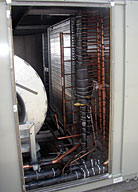"We have been developing the hot gas reheat feature for a few years," said Shawn Wood, Precedent/Voyager II product manager for Trane. "Trane's commitment to environmentally responsible HVAC products, systems, and services has led to a number of important systems innovations - including dehumidification control.
"The customer's indoor environment benefits from humidity control, and the outdoor environment benefits from less energy use and a reduction in emissions that contribute to global warming. These enhanced features provide tremendous benefit to facilities located in markets where humidity can cause comfort and air quality issues, such as the southeastern United States."

How It Works
The hot gas reheat feature is designed to control humidity at a specific level in the conditioned space. This is usually required when the outside temperature is cool and humid. It controls humidity without expending additional energy to reheat the cooled air. With conventional systems, the cooled and dehumidified air would require the use of a heater to bring the temperature to the desired level.Hot gas reheat in Trane's systems recycles exhaust heat energy from the compressor and is intended to reduce indoor humidity while maintaining a comfortable air temperature. It is more efficient because it eliminates the need for a separate heat source to dehumidify the air, reducing heating costs.
The company's direct digital controls coordinate cooling and heating functions, and hot gas reheat during dehumidification cycles over a wide operating and ambient temperature range, in either constant volume or variable air volume (VAV) applications.
The digital controls also provide reheat capacity control; occupied, unoccupied, and disable functions; humidity set point control; and system protection features.
"Trane's hot gas reheat feature benefits all applications," Wood said. "For example, with heightened concerns about the effect of indoor air quality [IAQ] on the learning environment, both new and existing schools will benefit greatly from the enhanced humidity controls. Also, the restaurant industry maintains high exhaust and ventilation requirements and hot gas reheat allows buildings to better meet those requirements.

The hot gas reheat increases energy efficiency while maintaining strict control of temperature and humidity, whether high or low, by allowing the customer to directly control humidity with a humidity sensor. According to Wood, hot gas reheat also improves IAQ and can help reduce indoor moisture-related issues, helping to preserve building interiors and decreasing maintenance costs for building owners.
"Trane encourages them [customers] to consider maintenance costs of the building over time, rather than focusing on the initial purchase cost," Wood said. "Hot gas reheat can reduce routine maintenance and repair costs by contributing to reduced levels of indoor moisture-related issues.
"Additionally, recent studies have shown that good indoor air quality achieves higher employee productivity rates and worker satisfaction levels. This is especially relevant for the restaurant industry, where humidity and high temperatures caused by inadequate kitchen ventilation cause extreme discomfort for employees."
Hot gas reheat is also available in units ordered as part of Trane's recently announced large rooftop replacement program. The program offers contractors a 5 percent rebate on IntelliPak and Voyager IIIâ„¢ commercial air conditioning rooftop systems being used as replacements for comparable equipment.
To qualify for the rebate, contractors must sign up with their local Trane sales office and place orders by Aug. 15, 2005.
Publication date: 06/13/2005



